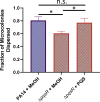Pseudomonas Quinolone Signal-Induced Outer Membrane Vesicles Enhance Biofilm Dispersion in Pseudomonas aeruginosa
- PMID: 33239369
- PMCID: PMC7690959
- DOI: 10.1128/mSphere.01109-20
Pseudomonas Quinolone Signal-Induced Outer Membrane Vesicles Enhance Biofilm Dispersion in Pseudomonas aeruginosa
Abstract
Bacterial biofilms are major contributors to chronic infections in humans. Because they are recalcitrant to conventional therapy, they present a particularly difficult treatment challenge. Identifying factors involved in biofilm development can help uncover novel targets and guide the development of antibiofilm strategies. Pseudomonas aeruginosa causes surgical site, burn wound, and hospital-acquired infections and is also associated with aggressive biofilm formation in the lungs of cystic fibrosis patients. A potent but poorly understood contributor to P. aeruginosa virulence is the ability to produce outer membrane vesicles (OMVs). OMV trafficking has been associated with cell-cell communication, virulence factor delivery, and transfer of antibiotic resistance genes. Because OMVs have almost exclusively been studied using planktonic cultures, little is known about their biogenesis and function in biofilms. Several groups have shown that Pseudomonas quinolone signal (PQS) induces OMV formation in P. aeruginosa Our group described a biophysical mechanism for this and recently showed it is operative in biofilms. Here, we demonstrate that PQS-induced OMV production is highly dynamic during biofilm development. Interestingly, PQS and OMV synthesis are significantly elevated during dispersion compared to attachment and maturation stages. PQS biosynthetic and receptor mutant biofilms were significantly impaired in their ability to disperse, but this phenotype was rescued by genetic complementation or exogenous addition of PQS. Finally, we show that purified OMVs can actively degrade extracellular protein, lipid, and DNA. We therefore propose that enhanced production of PQS-induced OMVs during biofilm dispersion facilitates cell escape by coordinating the controlled degradation of biofilm matrix components.IMPORTANCE Treatments that manipulate biofilm dispersion hold the potential to convert chronic drug-tolerant biofilm infections from protected sessile communities into released populations that are orders-of-magnitude more susceptible to antimicrobial treatment. However, dispersed cells often exhibit increased acute virulence and dissemination phenotypes. A thorough understanding of the dispersion process is therefore critical before this promising strategy can be effectively employed. Pseudomonas quinolone signal (PQS) has been implicated in early biofilm development, but we hypothesized that its function as an outer membrane vesicle (OMV) inducer may contribute at multiple stages. Here, we demonstrate that PQS and OMVs are differentially produced during Pseudomonas aeruginosa biofilm development and provide evidence that effective biofilm dispersion is dependent on the production of PQS-induced OMVs, which likely act as delivery vehicles for matrix-degrading enzymes. These findings lay the groundwork for understanding OMV contributions to biofilm development and suggest a model to explain the controlled matrix degradation that accompanies biofilm dispersion in many species.
Keywords: PQS; Pseudomonas aeruginosa; biofilms; dispersion; outer membrane vesicles; quorum sensing; secretion systems.
Copyright © 2020 Cooke et al.
Figures







Similar articles
-
Membrane Distribution of the Pseudomonas Quinolone Signal Modulates Outer Membrane Vesicle Production in Pseudomonas aeruginosa.mBio. 2017 Aug 8;8(4):e01034-17. doi: 10.1128/mBio.01034-17. mBio. 2017. PMID: 28790210 Free PMC article.
-
Analysis of Pseudomonas aeruginosa biofilm membrane vesicles supports multiple mechanisms of biogenesis.PLoS One. 2019 Feb 14;14(2):e0212275. doi: 10.1371/journal.pone.0212275. eCollection 2019. PLoS One. 2019. PMID: 30763382 Free PMC article.
-
Molecular conformation affects the interaction of the Pseudomonas quinolone signal with the bacterial outer membrane.J Biol Chem. 2019 Jan 25;294(4):1089-1094. doi: 10.1074/jbc.AC118.006844. Epub 2018 Dec 18. J Biol Chem. 2019. PMID: 30563840 Free PMC article.
-
Quorum sensing by 2-alkyl-4-quinolones in Pseudomonas aeruginosa and other bacterial species.Mol Biosyst. 2008 Sep;4(9):882-8. doi: 10.1039/b803796p. Epub 2008 Jun 30. Mol Biosyst. 2008. PMID: 18704225 Review.
-
Relationship between Pyochelin and Pseudomonas Quinolone Signal in Pseudomonas aeruginosa: A Direction for Future Research.Int J Mol Sci. 2024 Aug 7;25(16):8611. doi: 10.3390/ijms25168611. Int J Mol Sci. 2024. PMID: 39201297 Free PMC article. Review.
Cited by
-
Role of Host and Bacterial Lipids in Pseudomonas aeruginosa Respiratory Infections.Front Immunol. 2022 Jul 4;13:931027. doi: 10.3389/fimmu.2022.931027. eCollection 2022. Front Immunol. 2022. PMID: 35860265 Free PMC article. Review.
-
OprF impacts Pseudomonas aeruginosa biofilm matrix eDNA levels in a nutrient-dependent manner.bioRxiv [Preprint]. 2023 Mar 2:2023.03.01.530729. doi: 10.1101/2023.03.01.530729. bioRxiv. 2023. Update in: J Bacteriol. 2023 Jul 25;205(7):e0008023. doi: 10.1128/jb.00080-23. PMID: 36909500 Free PMC article. Updated. Preprint.
-
Molecular Aspects of the Functioning of Pathogenic Bacteria Biofilm Based on Quorum Sensing (QS) Signal-Response System and Innovative Non-Antibiotic Strategies for Their Elimination.Int J Mol Sci. 2024 Feb 24;25(5):2655. doi: 10.3390/ijms25052655. Int J Mol Sci. 2024. PMID: 38473900 Free PMC article. Review.
-
Molecular Mechanisms of Biofilm Formation in Helicobacter pylori.Antibiotics (Basel). 2024 Oct 16;13(10):976. doi: 10.3390/antibiotics13100976. Antibiotics (Basel). 2024. PMID: 39452242 Free PMC article. Review.
-
Potentiation of plant defense by bacterial outer membrane vesicles is mediated by membrane nanodomains.Plant Cell. 2022 Jan 20;34(1):395-417. doi: 10.1093/plcell/koab276. Plant Cell. 2022. PMID: 34791473 Free PMC article.
References
-
- Alhede M, Kragh KN, Qvortrup K, Allesen-Holm M, van Gennip M, Christensen LD, Jensen PØ, Nielsen AK, Parsek M, Wozniak D, Molin S, Tolker-Nielsen T, Høiby N, Givskov M, Bjarnsholt T. 2011. Phenotypes of non-attached Pseudomonas aeruginosa aggregates resemble surface attached biofilm. PLoS One 6:e27943. doi:10.1371/journal.pone.0027943. - DOI - PMC - PubMed
Publication types
MeSH terms
Substances
Grants and funding
LinkOut - more resources
Full Text Sources

